Case Study Analysis: RBA Cash Rate Decision, ECON 11026, Term 2
VerifiedAdded on 2023/06/04
|15
|4179
|474
Case Study
AI Summary
This case study delves into the Reserve Bank of Australia's (RBA) cash rate decisions, examining the factors influencing these choices and their implications for the Australian economy. It analyzes the RBA's role, the objectives of monetary policy, and the functions of money. The study explores how the RBA considers domestic and global macroeconomic indicators, such as GDP growth, inflation, and unemployment, when deciding whether to adjust the cash rate. It also investigates the reasons behind the RBA's decision to maintain the cash rate at 1.50 percent in August 2018, referencing specific economic conditions and data. The assignment adheres to the DADA framework, using data and graphs to support the analysis, providing a comprehensive understanding of the RBA's monetary policy decisions and their impact.
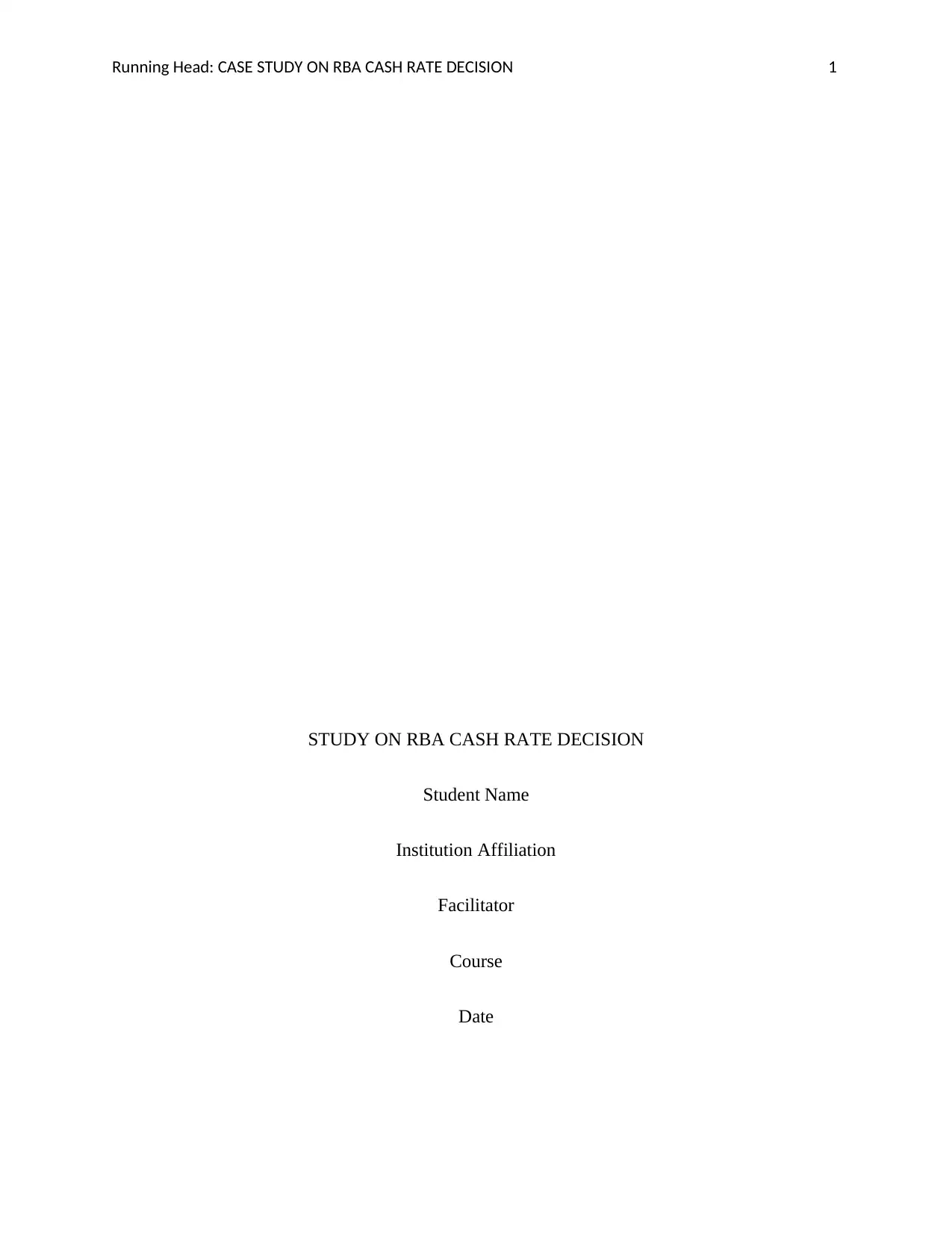
Running Head: CASE STUDY ON RBA CASH RATE DECISION 1
STUDY ON RBA CASH RATE DECISION
Student Name
Institution Affiliation
Facilitator
Course
Date
STUDY ON RBA CASH RATE DECISION
Student Name
Institution Affiliation
Facilitator
Course
Date
Paraphrase This Document
Need a fresh take? Get an instant paraphrase of this document with our AI Paraphraser
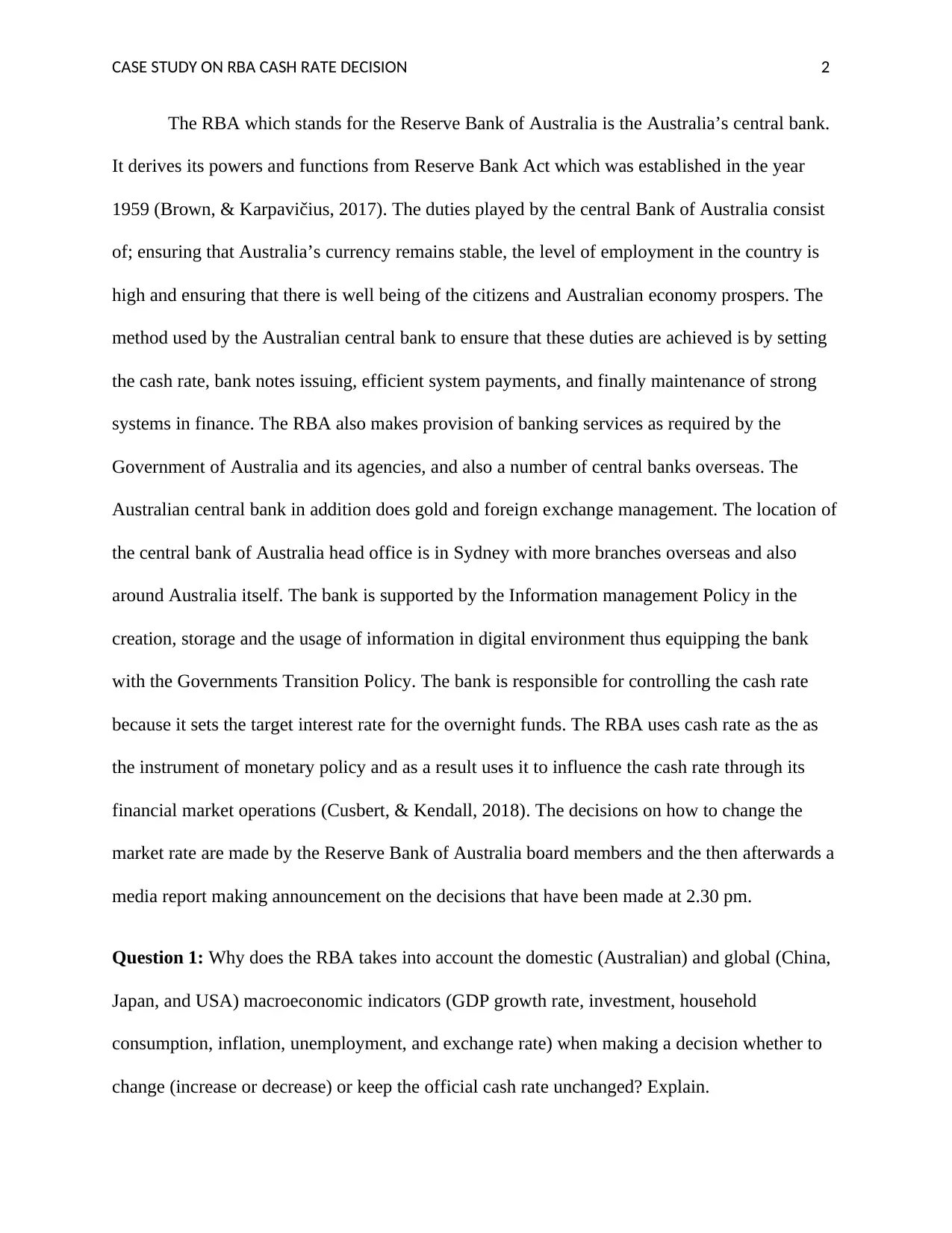
CASE STUDY ON RBA CASH RATE DECISION 2
The RBA which stands for the Reserve Bank of Australia is the Australia’s central bank.
It derives its powers and functions from Reserve Bank Act which was established in the year
1959 (Brown, & Karpavičius, 2017). The duties played by the central Bank of Australia consist
of; ensuring that Australia’s currency remains stable, the level of employment in the country is
high and ensuring that there is well being of the citizens and Australian economy prospers. The
method used by the Australian central bank to ensure that these duties are achieved is by setting
the cash rate, bank notes issuing, efficient system payments, and finally maintenance of strong
systems in finance. The RBA also makes provision of banking services as required by the
Government of Australia and its agencies, and also a number of central banks overseas. The
Australian central bank in addition does gold and foreign exchange management. The location of
the central bank of Australia head office is in Sydney with more branches overseas and also
around Australia itself. The bank is supported by the Information management Policy in the
creation, storage and the usage of information in digital environment thus equipping the bank
with the Governments Transition Policy. The bank is responsible for controlling the cash rate
because it sets the target interest rate for the overnight funds. The RBA uses cash rate as the as
the instrument of monetary policy and as a result uses it to influence the cash rate through its
financial market operations (Cusbert, & Kendall, 2018). The decisions on how to change the
market rate are made by the Reserve Bank of Australia board members and the then afterwards a
media report making announcement on the decisions that have been made at 2.30 pm.
Question 1: Why does the RBA takes into account the domestic (Australian) and global (China,
Japan, and USA) macroeconomic indicators (GDP growth rate, investment, household
consumption, inflation, unemployment, and exchange rate) when making a decision whether to
change (increase or decrease) or keep the official cash rate unchanged? Explain.
The RBA which stands for the Reserve Bank of Australia is the Australia’s central bank.
It derives its powers and functions from Reserve Bank Act which was established in the year
1959 (Brown, & Karpavičius, 2017). The duties played by the central Bank of Australia consist
of; ensuring that Australia’s currency remains stable, the level of employment in the country is
high and ensuring that there is well being of the citizens and Australian economy prospers. The
method used by the Australian central bank to ensure that these duties are achieved is by setting
the cash rate, bank notes issuing, efficient system payments, and finally maintenance of strong
systems in finance. The RBA also makes provision of banking services as required by the
Government of Australia and its agencies, and also a number of central banks overseas. The
Australian central bank in addition does gold and foreign exchange management. The location of
the central bank of Australia head office is in Sydney with more branches overseas and also
around Australia itself. The bank is supported by the Information management Policy in the
creation, storage and the usage of information in digital environment thus equipping the bank
with the Governments Transition Policy. The bank is responsible for controlling the cash rate
because it sets the target interest rate for the overnight funds. The RBA uses cash rate as the as
the instrument of monetary policy and as a result uses it to influence the cash rate through its
financial market operations (Cusbert, & Kendall, 2018). The decisions on how to change the
market rate are made by the Reserve Bank of Australia board members and the then afterwards a
media report making announcement on the decisions that have been made at 2.30 pm.
Question 1: Why does the RBA takes into account the domestic (Australian) and global (China,
Japan, and USA) macroeconomic indicators (GDP growth rate, investment, household
consumption, inflation, unemployment, and exchange rate) when making a decision whether to
change (increase or decrease) or keep the official cash rate unchanged? Explain.

CASE STUDY ON RBA CASH RATE DECISION 3
The Reserve Bank of Australia (RBA) looks into account and compares domestic and
global macroeconomic indicators because comparing the two brings out the best future
performance that reflect the position of the economy of Australia before agencies and the real
economic action occurs (Lane, & Rosewall, 2015). The reason behind this is that the Reserve
Bank of Australia has been given the task of ensuring that there is prosperity and well-being of
the people of Australia. To achieve this goal, they use the monetary policy in attempting to
control inflation, stabilize the Australian currency, maintain full employment in Australia, ensure
well-being of people of Australia and finally promote economic prosperity. The decision to
compare the domestic and the global economy depends on the amount of money circulating in
the economy which makes the RBA decide on whether to lower, raise or maintain the cash rate
(Chen, Zhang, Tam, & Wu, 2018). This is the point where the comparison is made between the
strengths of the larger growing economies i.e. the global economies and the domestic economy.
For the international economic conditions the Reserve Bank of Australia account for the
strengths of the global economy in terms of housing markets, the demand of the consumer and
the performance of the currencies. On the other side of domestic economic conditions, the
performance of the economy in terms of employment and unemployment level is checked. High
unemployment increases the chances of rate decreases because low rates boost business
expenditure, investments and the overall job employment. The inflation level is also checked
because when the inflation is high, it increases the chances of the consumer demand. In the
process of fighting inflation in the country RBA raised the cash rate to keep the inflation low
something they have done for many years to maintain inflation between 2 – 3%. RBA also
checks the business and consumer confidence because when business or consumer confidence is
low, then these two stimulate the likelihood of cash rate decrease because cash rate decrease
The Reserve Bank of Australia (RBA) looks into account and compares domestic and
global macroeconomic indicators because comparing the two brings out the best future
performance that reflect the position of the economy of Australia before agencies and the real
economic action occurs (Lane, & Rosewall, 2015). The reason behind this is that the Reserve
Bank of Australia has been given the task of ensuring that there is prosperity and well-being of
the people of Australia. To achieve this goal, they use the monetary policy in attempting to
control inflation, stabilize the Australian currency, maintain full employment in Australia, ensure
well-being of people of Australia and finally promote economic prosperity. The decision to
compare the domestic and the global economy depends on the amount of money circulating in
the economy which makes the RBA decide on whether to lower, raise or maintain the cash rate
(Chen, Zhang, Tam, & Wu, 2018). This is the point where the comparison is made between the
strengths of the larger growing economies i.e. the global economies and the domestic economy.
For the international economic conditions the Reserve Bank of Australia account for the
strengths of the global economy in terms of housing markets, the demand of the consumer and
the performance of the currencies. On the other side of domestic economic conditions, the
performance of the economy in terms of employment and unemployment level is checked. High
unemployment increases the chances of rate decreases because low rates boost business
expenditure, investments and the overall job employment. The inflation level is also checked
because when the inflation is high, it increases the chances of the consumer demand. In the
process of fighting inflation in the country RBA raised the cash rate to keep the inflation low
something they have done for many years to maintain inflation between 2 – 3%. RBA also
checks the business and consumer confidence because when business or consumer confidence is
low, then these two stimulate the likelihood of cash rate decrease because cash rate decrease
⊘ This is a preview!⊘
Do you want full access?
Subscribe today to unlock all pages.

Trusted by 1+ million students worldwide

CASE STUDY ON RBA CASH RATE DECISION 4
stimulates demand hence business expansion. The level of household debt is also looked at. It is
known historically that lower interest rates tend to boost the price of housing in capital city
business areas. Other methods such as the restriction on requirement of lending may also be
more effective in the control of housing market. The currency of the nation i.e. the nation of
Australia also tries to influence the strength of the dollar through the official cash rate. Is the
cash rate in our country is high, then the comparison to other western countries can make our
dollar strong thus investors investing in our country put more money in our country. On the other
hand, strong dollar might be god for the importers but also bad fot the exporters. The stability of
the financial markets is also checked on their lending and their deposit accounts rates in
particular. Finally the last review is in regard to their previous decision on the cash rate effects
on the social banking. Additionally they will give the weighing on how consistence inflation is to
their projections as well as the future outlook to their growth. Upon the discussion of the above
macroeconomic indicators, a comparison is made mostly for the housing markets overseas, the
demands of the consumers and the performance of the currencies of countries with higher
growing economies such as China, The United States of America and also some of the larger
European countries like Japan among others. Comparing the two help the RBA see the effects
that might arise after raising, maintain or lowering the official cash rate. Thus comparing the two
economies makes the Reserve Bank of Australia learns in advance the effects that might arise
after deciding on whether to rise, maintain or lower the cash rate hence enabling them change the
cash rate in the favor of the nation of Australia (Rey, 2015).
Question 2: Explain the main objectives of monetary policy. List and describe the main
functions of money and the Reserve Bank of Australia.
stimulates demand hence business expansion. The level of household debt is also looked at. It is
known historically that lower interest rates tend to boost the price of housing in capital city
business areas. Other methods such as the restriction on requirement of lending may also be
more effective in the control of housing market. The currency of the nation i.e. the nation of
Australia also tries to influence the strength of the dollar through the official cash rate. Is the
cash rate in our country is high, then the comparison to other western countries can make our
dollar strong thus investors investing in our country put more money in our country. On the other
hand, strong dollar might be god for the importers but also bad fot the exporters. The stability of
the financial markets is also checked on their lending and their deposit accounts rates in
particular. Finally the last review is in regard to their previous decision on the cash rate effects
on the social banking. Additionally they will give the weighing on how consistence inflation is to
their projections as well as the future outlook to their growth. Upon the discussion of the above
macroeconomic indicators, a comparison is made mostly for the housing markets overseas, the
demands of the consumers and the performance of the currencies of countries with higher
growing economies such as China, The United States of America and also some of the larger
European countries like Japan among others. Comparing the two help the RBA see the effects
that might arise after raising, maintain or lowering the official cash rate. Thus comparing the two
economies makes the Reserve Bank of Australia learns in advance the effects that might arise
after deciding on whether to rise, maintain or lower the cash rate hence enabling them change the
cash rate in the favor of the nation of Australia (Rey, 2015).
Question 2: Explain the main objectives of monetary policy. List and describe the main
functions of money and the Reserve Bank of Australia.
Paraphrase This Document
Need a fresh take? Get an instant paraphrase of this document with our AI Paraphraser

CASE STUDY ON RBA CASH RATE DECISION 5
First monetary policy refers to the policy laid out by the central bank for the management
of money supply, interest rates and used by the country’s government to achieve its
macroeconomic objectives such as growth, liquidity, inflation and consumption. The objectives
of monetary policy are: One, the maintenance of country’s currency stable (Llewellyn, 2016).
When stabilizing the currency, the main goal is to always keep checking the inflation. When the
money you have purchases little things today than the previous days, then this is what we call
inflation. It can be defined as the decrease in the purchasing power of money. Secondly, it is the
maintenance of full employment in the country. Full employment refers to a situation where
there is no unemployment. But in real sense this cannot happen because we cannot come to a
situation with zero unemployment. There might be some unemployment because people change
jobs, other prefer to stay unemployed waiting for a well-paying job than accepting a job that is
paying less. Therefore, when we say full employment we mean a situation where there are not
more than 3% of the population that is working are unemployed. We also have economic
prosperity and well-being of the people in a country which refers to the quality of the living
standards in an economy. Various factors are used to measure the economic welfare such as
GDP, literacy, level of pollution, and number of doctors. Money has various functions in the
country’s economy (Pham, Liu, & Roca, 2015). For instance money is used as a medium of
exchange to facilitate transactions. If money was absent, then all transactions would be done
through barter which involves exchanging goods and services for other goods and services.
Money is also used as a store of value. For money to be used as a medium of exchange, it must
possess a value equivalent to the product that it is being exchanged for. It is because of this
reason that money is said to be used as a store of value. Money is also used as a unit of account.
When used s a unit of account, it provides a common measure of goods and services being
First monetary policy refers to the policy laid out by the central bank for the management
of money supply, interest rates and used by the country’s government to achieve its
macroeconomic objectives such as growth, liquidity, inflation and consumption. The objectives
of monetary policy are: One, the maintenance of country’s currency stable (Llewellyn, 2016).
When stabilizing the currency, the main goal is to always keep checking the inflation. When the
money you have purchases little things today than the previous days, then this is what we call
inflation. It can be defined as the decrease in the purchasing power of money. Secondly, it is the
maintenance of full employment in the country. Full employment refers to a situation where
there is no unemployment. But in real sense this cannot happen because we cannot come to a
situation with zero unemployment. There might be some unemployment because people change
jobs, other prefer to stay unemployed waiting for a well-paying job than accepting a job that is
paying less. Therefore, when we say full employment we mean a situation where there are not
more than 3% of the population that is working are unemployed. We also have economic
prosperity and well-being of the people in a country which refers to the quality of the living
standards in an economy. Various factors are used to measure the economic welfare such as
GDP, literacy, level of pollution, and number of doctors. Money has various functions in the
country’s economy (Pham, Liu, & Roca, 2015). For instance money is used as a medium of
exchange to facilitate transactions. If money was absent, then all transactions would be done
through barter which involves exchanging goods and services for other goods and services.
Money is also used as a store of value. For money to be used as a medium of exchange, it must
possess a value equivalent to the product that it is being exchanged for. It is because of this
reason that money is said to be used as a store of value. Money is also used as a unit of account.
When used s a unit of account, it provides a common measure of goods and services being
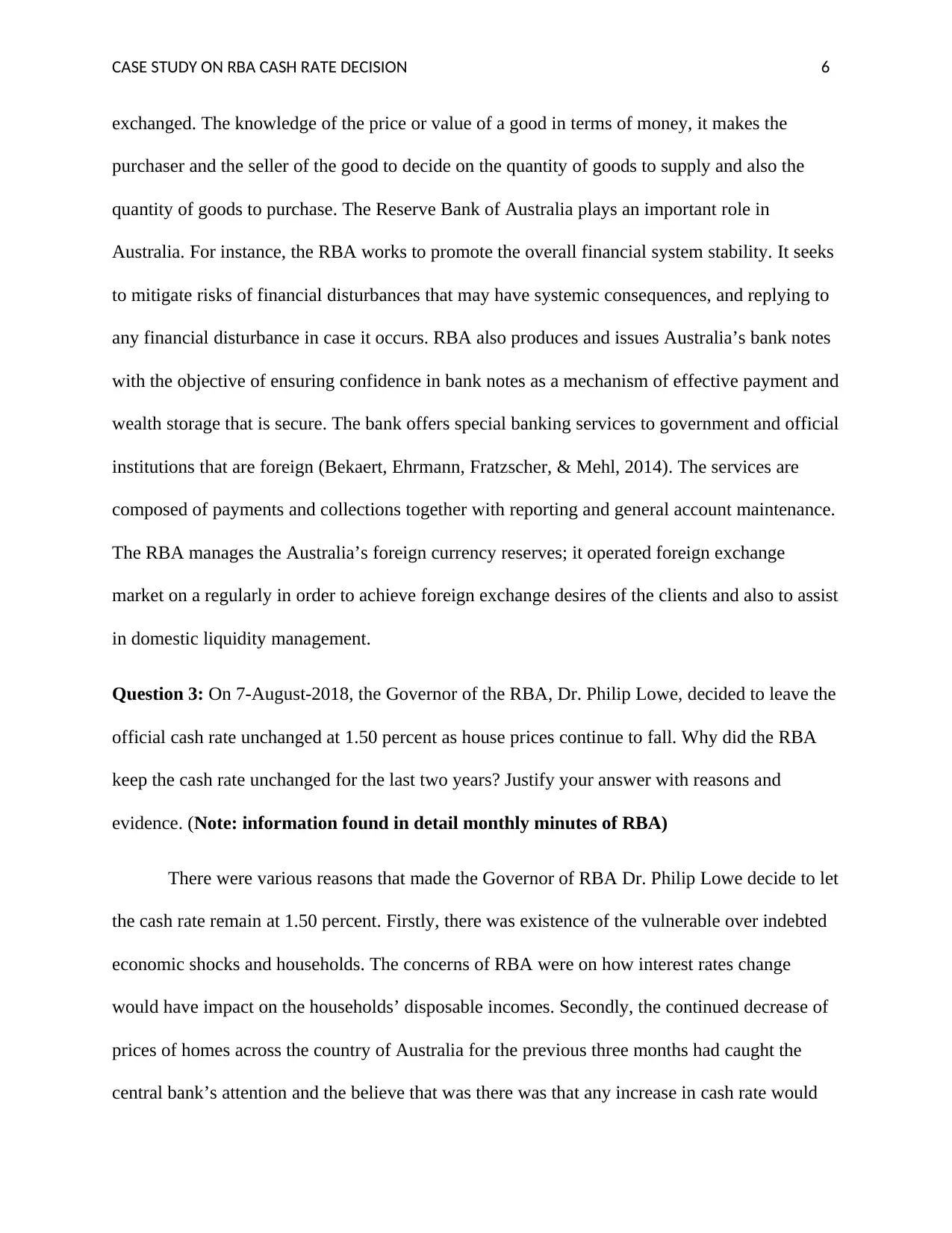
CASE STUDY ON RBA CASH RATE DECISION 6
exchanged. The knowledge of the price or value of a good in terms of money, it makes the
purchaser and the seller of the good to decide on the quantity of goods to supply and also the
quantity of goods to purchase. The Reserve Bank of Australia plays an important role in
Australia. For instance, the RBA works to promote the overall financial system stability. It seeks
to mitigate risks of financial disturbances that may have systemic consequences, and replying to
any financial disturbance in case it occurs. RBA also produces and issues Australia’s bank notes
with the objective of ensuring confidence in bank notes as a mechanism of effective payment and
wealth storage that is secure. The bank offers special banking services to government and official
institutions that are foreign (Bekaert, Ehrmann, Fratzscher, & Mehl, 2014). The services are
composed of payments and collections together with reporting and general account maintenance.
The RBA manages the Australia’s foreign currency reserves; it operated foreign exchange
market on a regularly in order to achieve foreign exchange desires of the clients and also to assist
in domestic liquidity management.
Question 3: On 7-August-2018, the Governor of the RBA, Dr. Philip Lowe, decided to leave the
official cash rate unchanged at 1.50 percent as house prices continue to fall. Why did the RBA
keep the cash rate unchanged for the last two years? Justify your answer with reasons and
evidence. (Note: information found in detail monthly minutes of RBA)
There were various reasons that made the Governor of RBA Dr. Philip Lowe decide to let
the cash rate remain at 1.50 percent. Firstly, there was existence of the vulnerable over indebted
economic shocks and households. The concerns of RBA were on how interest rates change
would have impact on the households’ disposable incomes. Secondly, the continued decrease of
prices of homes across the country of Australia for the previous three months had caught the
central bank’s attention and the believe that was there was that any increase in cash rate would
exchanged. The knowledge of the price or value of a good in terms of money, it makes the
purchaser and the seller of the good to decide on the quantity of goods to supply and also the
quantity of goods to purchase. The Reserve Bank of Australia plays an important role in
Australia. For instance, the RBA works to promote the overall financial system stability. It seeks
to mitigate risks of financial disturbances that may have systemic consequences, and replying to
any financial disturbance in case it occurs. RBA also produces and issues Australia’s bank notes
with the objective of ensuring confidence in bank notes as a mechanism of effective payment and
wealth storage that is secure. The bank offers special banking services to government and official
institutions that are foreign (Bekaert, Ehrmann, Fratzscher, & Mehl, 2014). The services are
composed of payments and collections together with reporting and general account maintenance.
The RBA manages the Australia’s foreign currency reserves; it operated foreign exchange
market on a regularly in order to achieve foreign exchange desires of the clients and also to assist
in domestic liquidity management.
Question 3: On 7-August-2018, the Governor of the RBA, Dr. Philip Lowe, decided to leave the
official cash rate unchanged at 1.50 percent as house prices continue to fall. Why did the RBA
keep the cash rate unchanged for the last two years? Justify your answer with reasons and
evidence. (Note: information found in detail monthly minutes of RBA)
There were various reasons that made the Governor of RBA Dr. Philip Lowe decide to let
the cash rate remain at 1.50 percent. Firstly, there was existence of the vulnerable over indebted
economic shocks and households. The concerns of RBA were on how interest rates change
would have impact on the households’ disposable incomes. Secondly, the continued decrease of
prices of homes across the country of Australia for the previous three months had caught the
central bank’s attention and the believe that was there was that any increase in cash rate would
⊘ This is a preview!⊘
Do you want full access?
Subscribe today to unlock all pages.

Trusted by 1+ million students worldwide
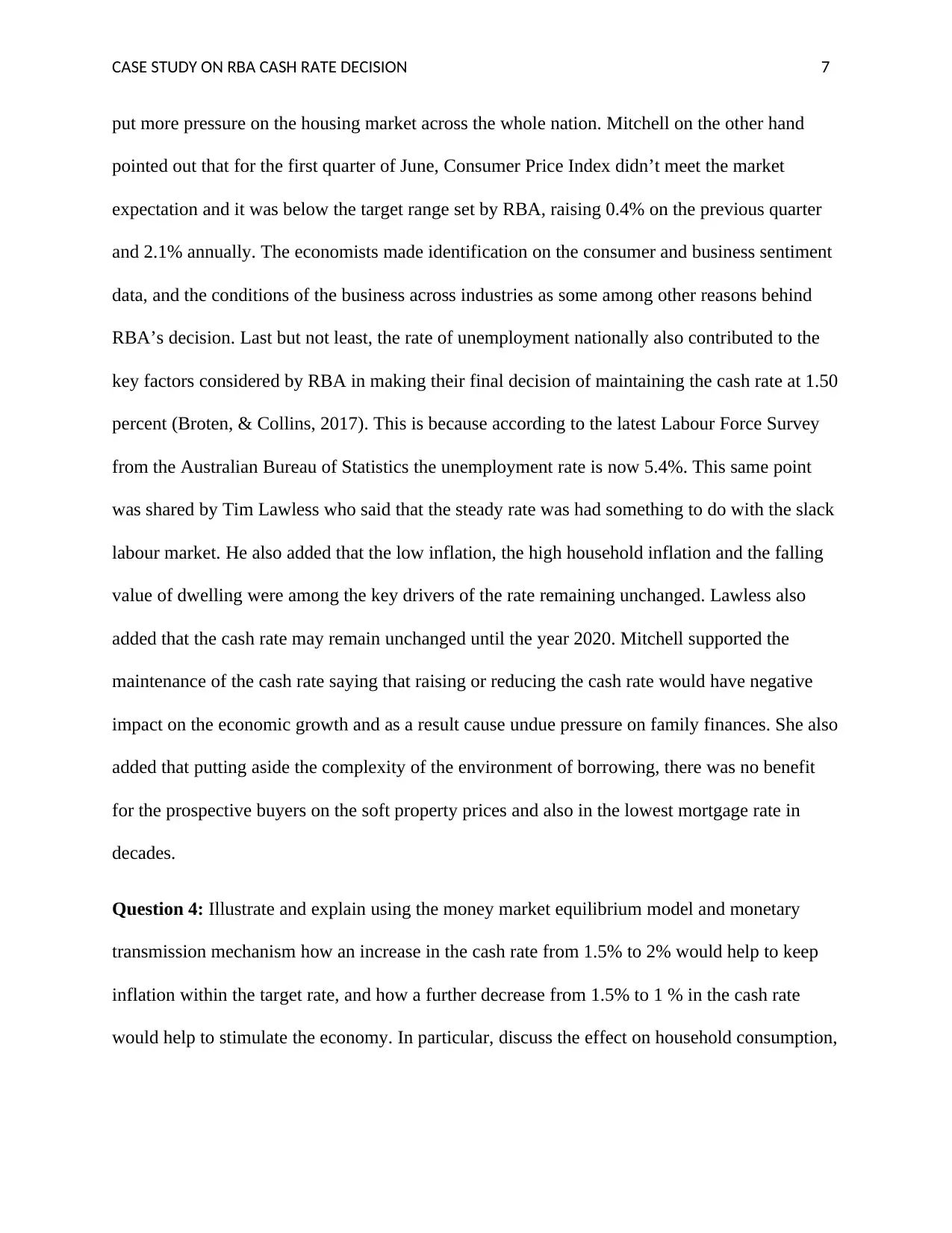
CASE STUDY ON RBA CASH RATE DECISION 7
put more pressure on the housing market across the whole nation. Mitchell on the other hand
pointed out that for the first quarter of June, Consumer Price Index didn’t meet the market
expectation and it was below the target range set by RBA, raising 0.4% on the previous quarter
and 2.1% annually. The economists made identification on the consumer and business sentiment
data, and the conditions of the business across industries as some among other reasons behind
RBA’s decision. Last but not least, the rate of unemployment nationally also contributed to the
key factors considered by RBA in making their final decision of maintaining the cash rate at 1.50
percent (Broten, & Collins, 2017). This is because according to the latest Labour Force Survey
from the Australian Bureau of Statistics the unemployment rate is now 5.4%. This same point
was shared by Tim Lawless who said that the steady rate was had something to do with the slack
labour market. He also added that the low inflation, the high household inflation and the falling
value of dwelling were among the key drivers of the rate remaining unchanged. Lawless also
added that the cash rate may remain unchanged until the year 2020. Mitchell supported the
maintenance of the cash rate saying that raising or reducing the cash rate would have negative
impact on the economic growth and as a result cause undue pressure on family finances. She also
added that putting aside the complexity of the environment of borrowing, there was no benefit
for the prospective buyers on the soft property prices and also in the lowest mortgage rate in
decades.
Question 4: Illustrate and explain using the money market equilibrium model and monetary
transmission mechanism how an increase in the cash rate from 1.5% to 2% would help to keep
inflation within the target rate, and how a further decrease from 1.5% to 1 % in the cash rate
would help to stimulate the economy. In particular, discuss the effect on household consumption,
put more pressure on the housing market across the whole nation. Mitchell on the other hand
pointed out that for the first quarter of June, Consumer Price Index didn’t meet the market
expectation and it was below the target range set by RBA, raising 0.4% on the previous quarter
and 2.1% annually. The economists made identification on the consumer and business sentiment
data, and the conditions of the business across industries as some among other reasons behind
RBA’s decision. Last but not least, the rate of unemployment nationally also contributed to the
key factors considered by RBA in making their final decision of maintaining the cash rate at 1.50
percent (Broten, & Collins, 2017). This is because according to the latest Labour Force Survey
from the Australian Bureau of Statistics the unemployment rate is now 5.4%. This same point
was shared by Tim Lawless who said that the steady rate was had something to do with the slack
labour market. He also added that the low inflation, the high household inflation and the falling
value of dwelling were among the key drivers of the rate remaining unchanged. Lawless also
added that the cash rate may remain unchanged until the year 2020. Mitchell supported the
maintenance of the cash rate saying that raising or reducing the cash rate would have negative
impact on the economic growth and as a result cause undue pressure on family finances. She also
added that putting aside the complexity of the environment of borrowing, there was no benefit
for the prospective buyers on the soft property prices and also in the lowest mortgage rate in
decades.
Question 4: Illustrate and explain using the money market equilibrium model and monetary
transmission mechanism how an increase in the cash rate from 1.5% to 2% would help to keep
inflation within the target rate, and how a further decrease from 1.5% to 1 % in the cash rate
would help to stimulate the economy. In particular, discuss the effect on household consumption,
Paraphrase This Document
Need a fresh take? Get an instant paraphrase of this document with our AI Paraphraser
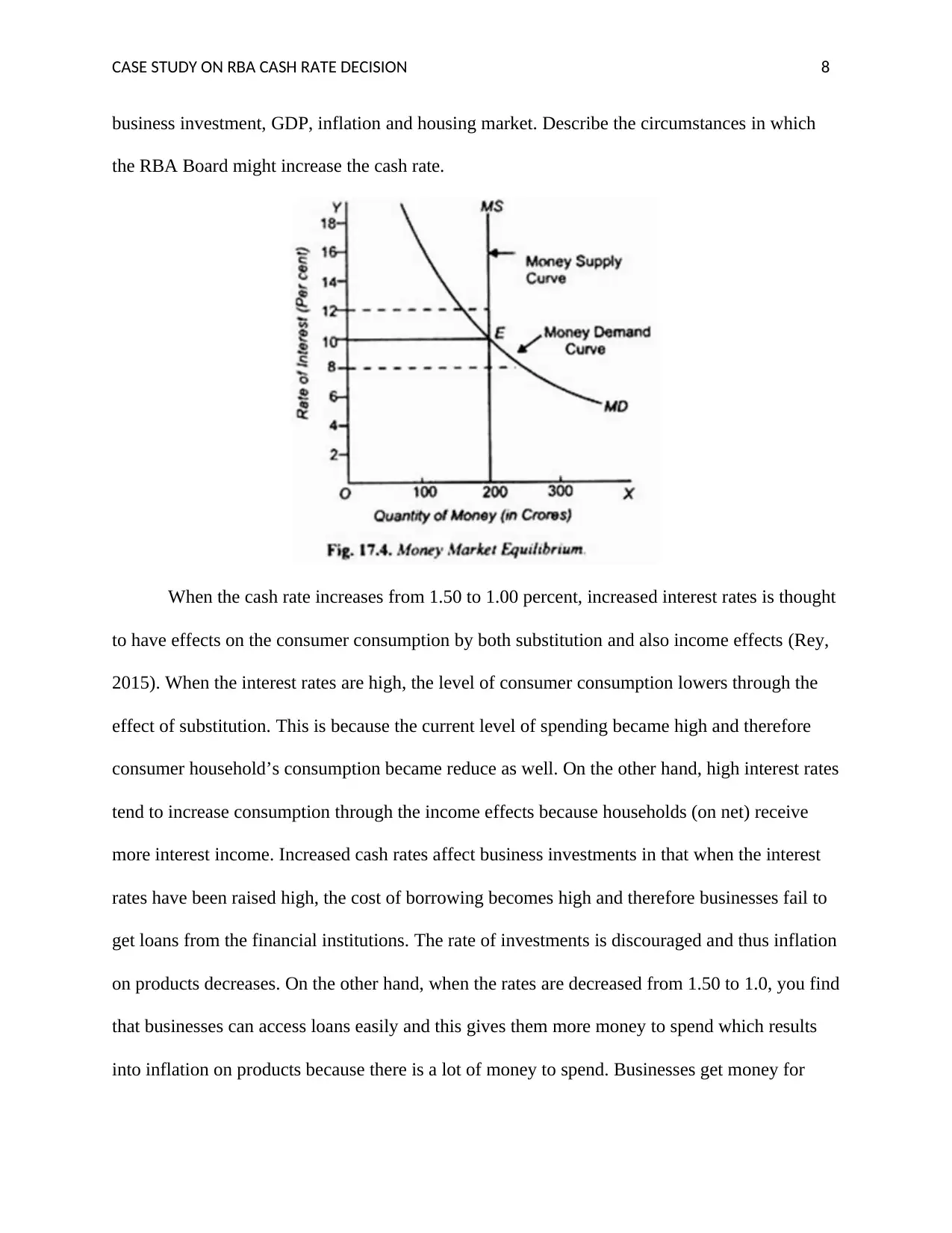
CASE STUDY ON RBA CASH RATE DECISION 8
business investment, GDP, inflation and housing market. Describe the circumstances in which
the RBA Board might increase the cash rate.
When the cash rate increases from 1.50 to 1.00 percent, increased interest rates is thought
to have effects on the consumer consumption by both substitution and also income effects (Rey,
2015). When the interest rates are high, the level of consumer consumption lowers through the
effect of substitution. This is because the current level of spending became high and therefore
consumer household’s consumption became reduce as well. On the other hand, high interest rates
tend to increase consumption through the income effects because households (on net) receive
more interest income. Increased cash rates affect business investments in that when the interest
rates have been raised high, the cost of borrowing becomes high and therefore businesses fail to
get loans from the financial institutions. The rate of investments is discouraged and thus inflation
on products decreases. On the other hand, when the rates are decreased from 1.50 to 1.0, you find
that businesses can access loans easily and this gives them more money to spend which results
into inflation on products because there is a lot of money to spend. Businesses get money for
business investment, GDP, inflation and housing market. Describe the circumstances in which
the RBA Board might increase the cash rate.
When the cash rate increases from 1.50 to 1.00 percent, increased interest rates is thought
to have effects on the consumer consumption by both substitution and also income effects (Rey,
2015). When the interest rates are high, the level of consumer consumption lowers through the
effect of substitution. This is because the current level of spending became high and therefore
consumer household’s consumption became reduce as well. On the other hand, high interest rates
tend to increase consumption through the income effects because households (on net) receive
more interest income. Increased cash rates affect business investments in that when the interest
rates have been raised high, the cost of borrowing becomes high and therefore businesses fail to
get loans from the financial institutions. The rate of investments is discouraged and thus inflation
on products decreases. On the other hand, when the rates are decreased from 1.50 to 1.0, you find
that businesses can access loans easily and this gives them more money to spend which results
into inflation on products because there is a lot of money to spend. Businesses get money for
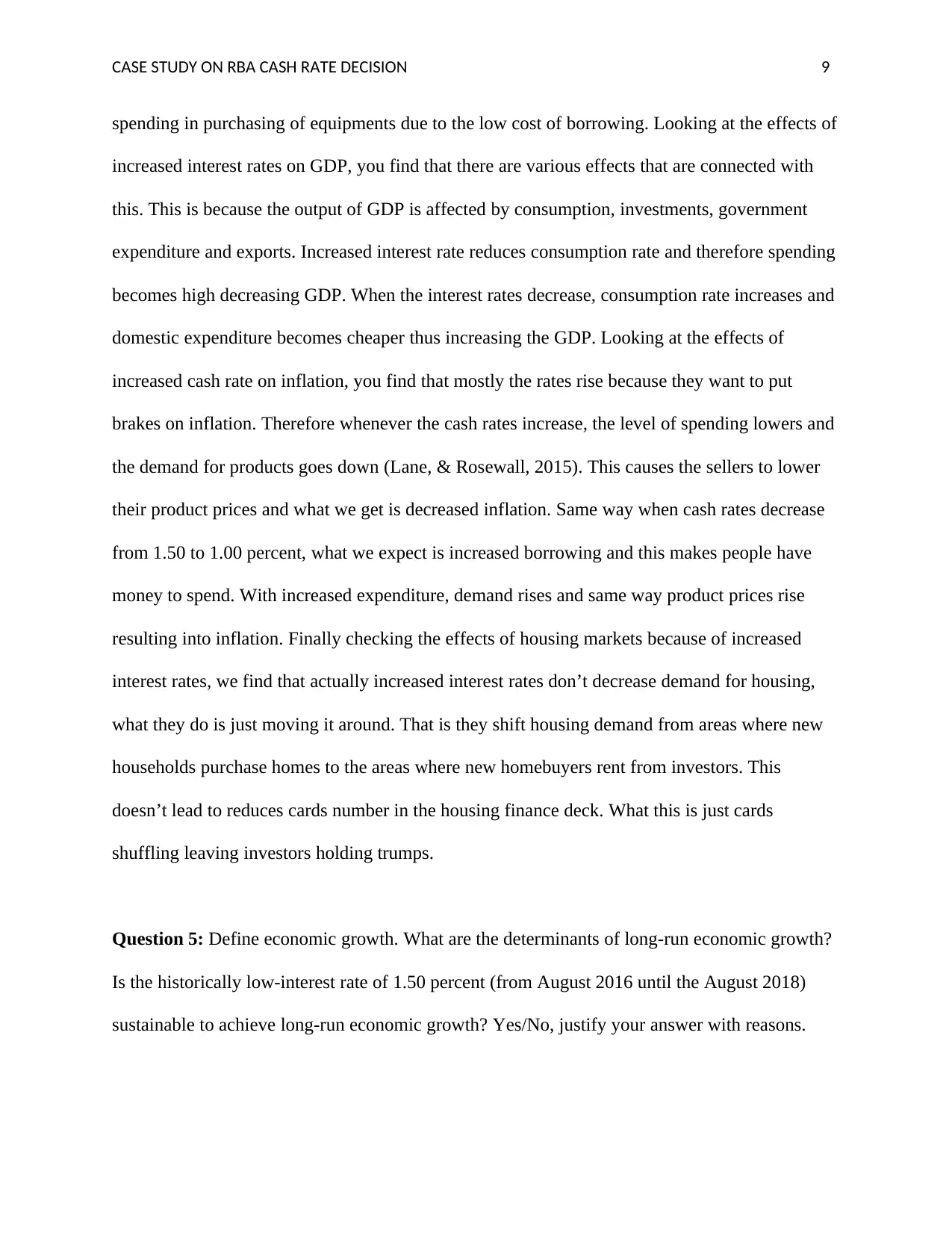
CASE STUDY ON RBA CASH RATE DECISION 9
spending in purchasing of equipments due to the low cost of borrowing. Looking at the effects of
increased interest rates on GDP, you find that there are various effects that are connected with
this. This is because the output of GDP is affected by consumption, investments, government
expenditure and exports. Increased interest rate reduces consumption rate and therefore spending
becomes high decreasing GDP. When the interest rates decrease, consumption rate increases and
domestic expenditure becomes cheaper thus increasing the GDP. Looking at the effects of
increased cash rate on inflation, you find that mostly the rates rise because they want to put
brakes on inflation. Therefore whenever the cash rates increase, the level of spending lowers and
the demand for products goes down (Lane, & Rosewall, 2015). This causes the sellers to lower
their product prices and what we get is decreased inflation. Same way when cash rates decrease
from 1.50 to 1.00 percent, what we expect is increased borrowing and this makes people have
money to spend. With increased expenditure, demand rises and same way product prices rise
resulting into inflation. Finally checking the effects of housing markets because of increased
interest rates, we find that actually increased interest rates don’t decrease demand for housing,
what they do is just moving it around. That is they shift housing demand from areas where new
households purchase homes to the areas where new homebuyers rent from investors. This
doesn’t lead to reduces cards number in the housing finance deck. What this is just cards
shuffling leaving investors holding trumps.
Question 5: Define economic growth. What are the determinants of long-run economic growth?
Is the historically low-interest rate of 1.50 percent (from August 2016 until the August 2018)
sustainable to achieve long-run economic growth? Yes/No, justify your answer with reasons.
spending in purchasing of equipments due to the low cost of borrowing. Looking at the effects of
increased interest rates on GDP, you find that there are various effects that are connected with
this. This is because the output of GDP is affected by consumption, investments, government
expenditure and exports. Increased interest rate reduces consumption rate and therefore spending
becomes high decreasing GDP. When the interest rates decrease, consumption rate increases and
domestic expenditure becomes cheaper thus increasing the GDP. Looking at the effects of
increased cash rate on inflation, you find that mostly the rates rise because they want to put
brakes on inflation. Therefore whenever the cash rates increase, the level of spending lowers and
the demand for products goes down (Lane, & Rosewall, 2015). This causes the sellers to lower
their product prices and what we get is decreased inflation. Same way when cash rates decrease
from 1.50 to 1.00 percent, what we expect is increased borrowing and this makes people have
money to spend. With increased expenditure, demand rises and same way product prices rise
resulting into inflation. Finally checking the effects of housing markets because of increased
interest rates, we find that actually increased interest rates don’t decrease demand for housing,
what they do is just moving it around. That is they shift housing demand from areas where new
households purchase homes to the areas where new homebuyers rent from investors. This
doesn’t lead to reduces cards number in the housing finance deck. What this is just cards
shuffling leaving investors holding trumps.
Question 5: Define economic growth. What are the determinants of long-run economic growth?
Is the historically low-interest rate of 1.50 percent (from August 2016 until the August 2018)
sustainable to achieve long-run economic growth? Yes/No, justify your answer with reasons.
⊘ This is a preview!⊘
Do you want full access?
Subscribe today to unlock all pages.

Trusted by 1+ million students worldwide
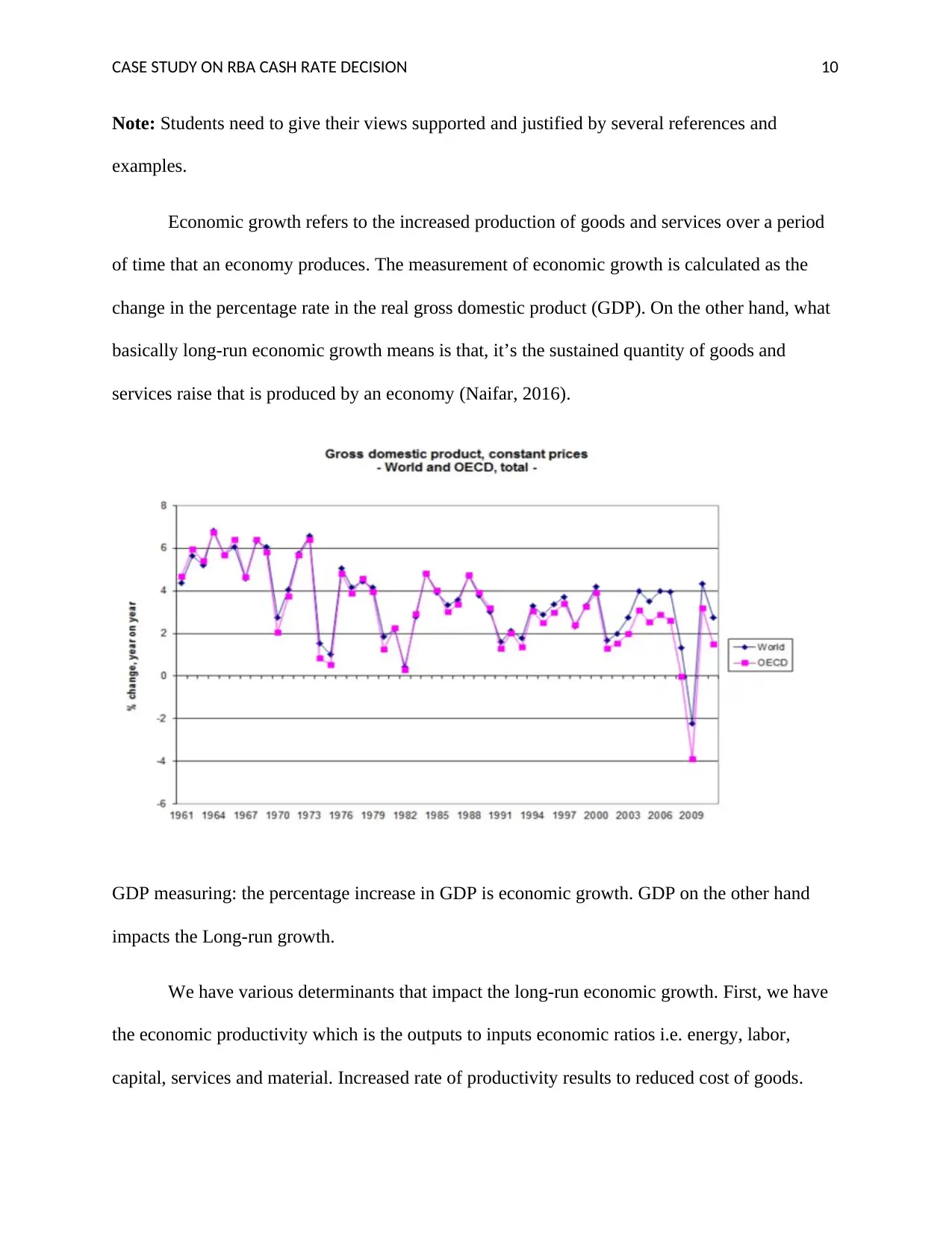
CASE STUDY ON RBA CASH RATE DECISION 10
Note: Students need to give their views supported and justified by several references and
examples.
Economic growth refers to the increased production of goods and services over a period
of time that an economy produces. The measurement of economic growth is calculated as the
change in the percentage rate in the real gross domestic product (GDP). On the other hand, what
basically long-run economic growth means is that, it’s the sustained quantity of goods and
services raise that is produced by an economy (Naifar, 2016).
GDP measuring: the percentage increase in GDP is economic growth. GDP on the other hand
impacts the Long-run growth.
We have various determinants that impact the long-run economic growth. First, we have
the economic productivity which is the outputs to inputs economic ratios i.e. energy, labor,
capital, services and material. Increased rate of productivity results to reduced cost of goods.
Note: Students need to give their views supported and justified by several references and
examples.
Economic growth refers to the increased production of goods and services over a period
of time that an economy produces. The measurement of economic growth is calculated as the
change in the percentage rate in the real gross domestic product (GDP). On the other hand, what
basically long-run economic growth means is that, it’s the sustained quantity of goods and
services raise that is produced by an economy (Naifar, 2016).
GDP measuring: the percentage increase in GDP is economic growth. GDP on the other hand
impacts the Long-run growth.
We have various determinants that impact the long-run economic growth. First, we have
the economic productivity which is the outputs to inputs economic ratios i.e. energy, labor,
capital, services and material. Increased rate of productivity results to reduced cost of goods.
Paraphrase This Document
Need a fresh take? Get an instant paraphrase of this document with our AI Paraphraser

CASE STUDY ON RBA CASH RATE DECISION 11
Reduced product priced leads to increase demand of the product or service by the consumers and
thus increased demand results into higher revenues (Atkin, & La Cava, 2017). Secondly, we have
demographic changes which influence economic growth by the employment ratio change. Some
of the factors consist of quantity and the quality of the natural resources availability. The long-
run growth is also influenced by the structure of the age of the population. Thirdly, we have
Labor force participation. Here the economic sectors size and the participation of the labor force
influence labor force. What actually labour force means is the amount or number of workers
available. Most of countries that are undergoing extensive development and industrialization, the
level of participation of labor force is high because of low birth rate and death rate (Galí, 2015).
Is the historically low-interest rate of 1.50 percent (from August 2016 until the August 2018)
sustainable to achieve long-run economic growth?
Yes.
Reduced product priced leads to increase demand of the product or service by the consumers and
thus increased demand results into higher revenues (Atkin, & La Cava, 2017). Secondly, we have
demographic changes which influence economic growth by the employment ratio change. Some
of the factors consist of quantity and the quality of the natural resources availability. The long-
run growth is also influenced by the structure of the age of the population. Thirdly, we have
Labor force participation. Here the economic sectors size and the participation of the labor force
influence labor force. What actually labour force means is the amount or number of workers
available. Most of countries that are undergoing extensive development and industrialization, the
level of participation of labor force is high because of low birth rate and death rate (Galí, 2015).
Is the historically low-interest rate of 1.50 percent (from August 2016 until the August 2018)
sustainable to achieve long-run economic growth?
Yes.
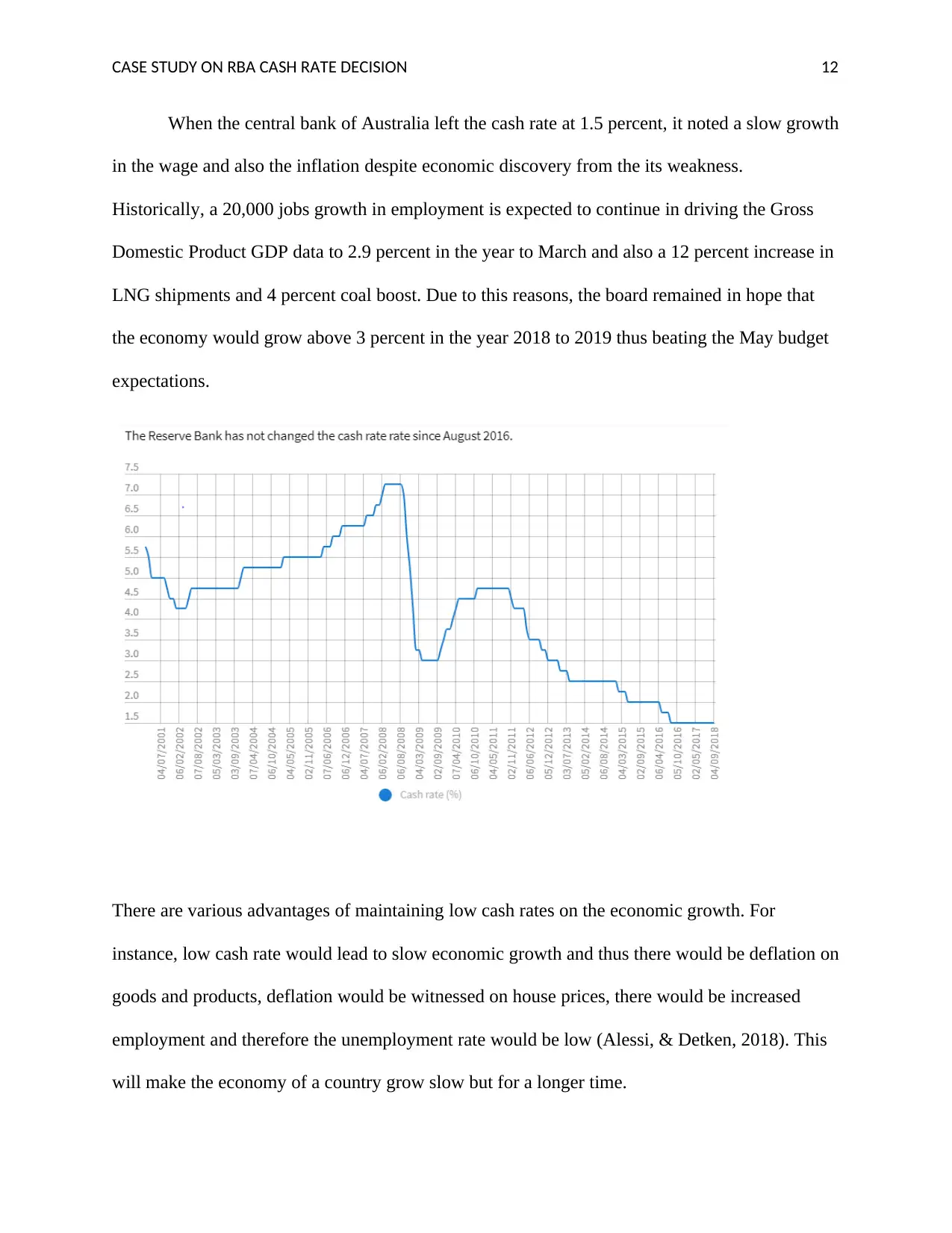
CASE STUDY ON RBA CASH RATE DECISION 12
When the central bank of Australia left the cash rate at 1.5 percent, it noted a slow growth
in the wage and also the inflation despite economic discovery from the its weakness.
Historically, a 20,000 jobs growth in employment is expected to continue in driving the Gross
Domestic Product GDP data to 2.9 percent in the year to March and also a 12 percent increase in
LNG shipments and 4 percent coal boost. Due to this reasons, the board remained in hope that
the economy would grow above 3 percent in the year 2018 to 2019 thus beating the May budget
expectations.
There are various advantages of maintaining low cash rates on the economic growth. For
instance, low cash rate would lead to slow economic growth and thus there would be deflation on
goods and products, deflation would be witnessed on house prices, there would be increased
employment and therefore the unemployment rate would be low (Alessi, & Detken, 2018). This
will make the economy of a country grow slow but for a longer time.
When the central bank of Australia left the cash rate at 1.5 percent, it noted a slow growth
in the wage and also the inflation despite economic discovery from the its weakness.
Historically, a 20,000 jobs growth in employment is expected to continue in driving the Gross
Domestic Product GDP data to 2.9 percent in the year to March and also a 12 percent increase in
LNG shipments and 4 percent coal boost. Due to this reasons, the board remained in hope that
the economy would grow above 3 percent in the year 2018 to 2019 thus beating the May budget
expectations.
There are various advantages of maintaining low cash rates on the economic growth. For
instance, low cash rate would lead to slow economic growth and thus there would be deflation on
goods and products, deflation would be witnessed on house prices, there would be increased
employment and therefore the unemployment rate would be low (Alessi, & Detken, 2018). This
will make the economy of a country grow slow but for a longer time.
⊘ This is a preview!⊘
Do you want full access?
Subscribe today to unlock all pages.

Trusted by 1+ million students worldwide
1 out of 15
Related Documents
Your All-in-One AI-Powered Toolkit for Academic Success.
+13062052269
info@desklib.com
Available 24*7 on WhatsApp / Email
![[object Object]](/_next/static/media/star-bottom.7253800d.svg)
Unlock your academic potential
Copyright © 2020–2025 A2Z Services. All Rights Reserved. Developed and managed by ZUCOL.




